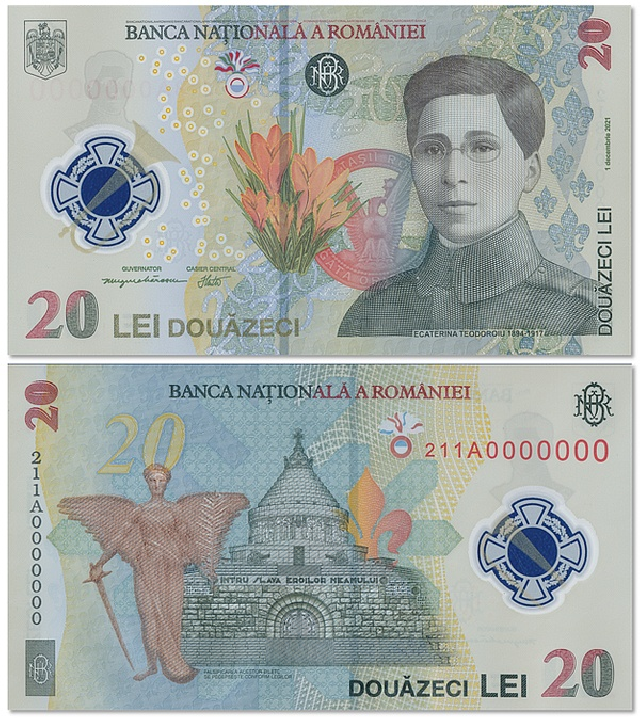Feminine symbols in Romanian history
Ecaterina Tedoroiu and Smaranda Brăescu continued to serve as role-models long after their death

Steliu Lambru, 10.01.2022, 14:00
On December 1,
2021, the Central Bank of Romania issued a new bank bill worth 20 Lei, that is
approximately 4 Euro, featuring Ecaterina Teodoroiu, a heroine of the First
World War. Also in December last year, the government adopted a law whereby
2022 is devoted to Smaranda Brăescu, the first female parachute jumper. The two
figures pay homage to the heritage and efforts of Romanian women throughout
history and a tribute to those who gave their lives alongside men. Ecaterina
Teodoroiu and Smaranda Brăescu were two women who experienced great hardships,
yet had the strength to continue pursuing their passion and vocation.
Ecaterina
Teodoroiu was the heroine-symbol of the First World War. The woman-soldier who
didn’t want to stay behind the frontline, but always sought to be in the heat
of battle, Ecaterina Teodoroiu was born in 1894 in Gorj County into a peasant
family. She was a hardworking pupil, and before getting admitted in a
high-school in Bucharest, where she wanted to become a teacher, she graduated
the German school in Târgu Jiu. She also enrolled in a medical school for
nurses. Romania entered the war in August 1916, a decision met with enthusiasm by
the population, many young people choosing to enlist. Ecaterina Teodoroiu was
among them, signing up for the hard life of war. For her participation in the battles,
Ecaterina was decorated and promoted to lieutenant, second class. On August 22,
1917, her regiment got stormed by the German army, sending the Romanian army on
the retreat. Ecaterina Teodoroiu got shot in the head by two bullets fired from
a machine gun. She died on the spot. Historian Ioan Scurtu says Ecaterina
Teodoroiu became a legend of the Great War.
Ever since
1917-1918, Ecaterina Teodoroiu became a legend. Those who fought beside her,
part of her own unit, told stories of her bravery, courage and heroics. The fact
that a woman got to fight in actual battles become highly symbolic. When she
got out of hospital, she got requests to stay work for the Red Cross together
with other women, including Queen Mary, but she refused. She said she belonged
on the frontline, was eager to stay and fight. In 1921, as Romania marked 100
years since Tudor Vladimirescu’s uprising, her earthly remains were transported
to the monument in Mărășești in Târgu Jiu. A special sarcophagus was built in
her honor by sculptor Milița Pătrașcu. King Ferdinand and Queen Mary, historian
Nicolae Iorga, Marshal Alexandru Averescu as well as everyone who contributed
to leading Romania and building a symbol for the 800,000 Romanians who died in
the war, sought to praise Ecaterina Teodoroiu.
Smaranda Brăescu
was born in 1897 in Tecuci, eastern Romania. She was the first woman-pilot, the
first woman-parachute jumper and the first woman to train military pilots in
Romania. She displayed true grit and followed her passion with extraordinary
tenacity. She became European champion in parachute jumping in 1931 at the age
of 34, when she jumped 6,000 meters, setting a new European record, as well as world
champion in 1932, when she jumped 7,400 meters at the Sacramento tournament in
the United States, setting a world record that would last 20 years. She is the
recipient of the Aeronautics Virtue Order, Golden Cross class. She was equally
devoted to her intellectual training. Smaranda graduated the Fine Arts Academy
in Bucharest, the decorative art and ceramics department.
Ana-Maria
Sireteanu, Smaranda Brăescu’s great granddaughter, recalls Smaranda Brăescuțs
strength of character could not be broken even after a very serious accident:
In Satu Mare, after
a jump, her parachute swept her away and she injured both her legs. This could
also be a sign for anyone looking for earthly remains, as her leg injuries
would show. She spent 5 months in the hospital and a very talented doctor
performed surgery and she managed to recover. 7 months later, after having
sustained such extensive injuries, she managed to set the European and world
records, in 1931 and 1932. That is evidence of her extraordinary motivation and
willingness to bring glory to her country.
During the war,
Smaranda was a member of the famous white squadron, a squadron of medivac
planes on the eastern front and later on the western front in Transylvania,
Hungary and Czechoslovakia. She signed a memorandum condemning the rigged
elections of November 1946. Wanted by the communist authorities, Smaranda Brăescu
disappeared. She is thought to have spent the last days of her life at a
nunnery, dying on February 2, 1948, aged 51. (VP)






























